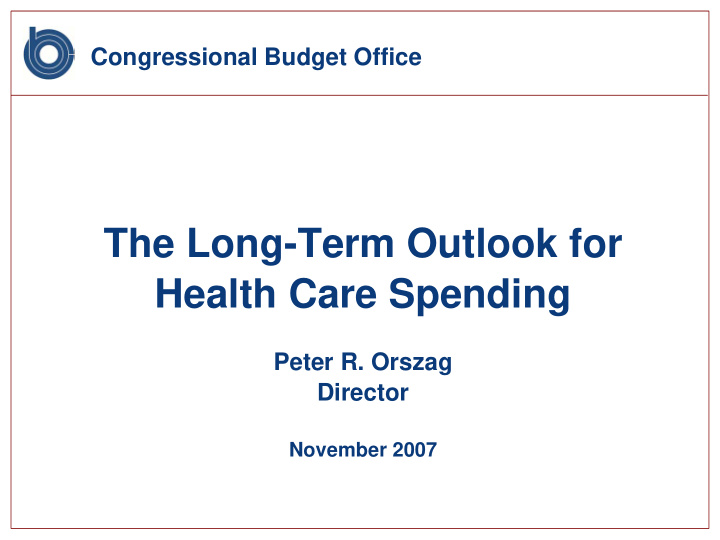



Congressional Budget Office The Long-Term Outlook for Health Care Spending Peter R. Orszag Director November 2007
Spending on Health Care as a Percentage of Gross Domestic Product Percent 18 16 14 12 10 8 All Other Health Care 6 4 Medicaid 2 Medicare 0 1960 1965 1970 1975 1980 1985 1990 1995 2000 2005
Excess Cost Growth in Medicare, Medicaid, and All Other Spending on Health Care Percentage Points Medicare Medicaid All Other Total 1975 to 1990 2.9 2.9 2.4 2.6 1990 to 2005 1.8 1.3 1.4 1.5 1975 to 2005 2.4 2.2 2.0 2.1
Excess Cost Growth in Medicare, Medicaid, and All Other Spending on Health Care Percent 20 Medicaid 15 10 Other Total Medicare 5 0 -5 -10 1976 1980 1984 1988 1992 1996 2000 2004
Spending on Health Care as a Percentage of Gross Domestic Product Under an Assumption That Excess Cost Growth Continues at Historical Averages Percent 100 90 80 70 60 50 All Other Health Care 40 30 Medicaid 20 10 Medicare 0 2007 2012 2017 2022 2027 2032 2037 2042 2047 2052 2057 2062 2067 2072 2077 2082
Projected Spending on Health Care as a Percentage of Gross Domestic Product Percent 50 45 40 35 30 All Other Health Care 25 20 15 Medicaid 10 Medicare 5 0 2007 2012 2017 2022 2027 2032 2037 2042 2047 2052 2057 2062 2067 2072 2077 2082
Federal Spending for Medicare and Medicaid as a Percentage of Gross Domestic Product Under Different Assumptions About Excess Cost Growth Percent 40 Excess Cost Growth of: 35 2.5 Percentage Points 1 Percentage Point 30 Zero 25 20 CBO's Projection 15 10 5 0 2007 2012 2017 2022 2027 2032 2037 2042 2047 2052 2057 2062 2067 2072 2077 2082
CBO’s and the Trustees’ Projections of Spending on Medicare as a Percentage of Gross Domestic Product Percent 18 16 14 CBO 12 Trustees 10 8 6 4 2 0 2007 2012 2017 2022 2027 2032 2037 2042 2047 2052 2057 2062 2067 2072 2077 2082
Sources of Growth in Projected Federal Spending on Medicare and Medicaid Percentage of GDP 20 15 10 Effect of Excess Cost Growth Effect of the Aging of the Population 5 0 2007 2012 2017 2022 2027 2032 2037 2042 2047 2052 2057 2062 2067 2072 2077 2082
The Medical Effectiveness Curve Outcome Cost Cost
Medicare Spending per Capita in the United States, by Hospital Referral Region, 2003 $7,200 to 11,600 (74) 6,300 to < 6,800 (55) 4,500 to < 5,800 (72) 6,800 to < 7,200 (45) 5,800 to < 6,300 (60) Not Populated Source: www.dartmouthatlas.org.
The Relationship Between Quality and Medicare Spending, by State, 2004 Composite Measure of Quality of Care 88 83 78 73 4,000 5,000 6,000 7,000 8,000 Spending (Dollars) Source: Data from AHRQ and CMS.
What Additional Services Are Provided in High-Spending Regions? Source: Elliot Fisher, Dartmouth Medical School.
Variations Among Academic Medical Centers Use of Biologically Targeted Interventions and Care-Delivery Methods Among Three of U.S. News and World Report ’s “Honor Roll” AMCs UCLA Massachusetts Mayo Clinic Medical General (St. Mary’s Center Hospital Hospital) Biologically Targeted Interventions: Acute Inpatient Care CMS composite quality score 81.5 85.9 90.4 Care Delivery ― and Spending ― Among Medicare Patients in Last Six Months of Life Total Medicare spending 50,522 40,181 26,330 Hospital days 19.2 17.7 12.9 Physician visits 52.1 42.2 23.9 Ratio, medical specialist / primary care 2.9 1.0 1.1 Source: Elliot Fisher, Dartmouth Medical School.
Share of Personal Health Care Expenditures Paid Out of Pocket Percent 35 33% 30 25 26% 20 15 17% 15% 13% 10 5 0 1975 1985 1995 2005 2015
Concentration of Total Annual Medicare Expenditures Among Beneficiaries, 2001 Percent 100 5 5 90 15 80 43.1 70 25 60 50 18.4 40 30 23.5 50 20 10 11.2 3.8 0 Beneficiaries Expenditures Source: CBO based on data from CMS.
Recommend
More recommend